Report on Early Childhood Education and Care (Birth-5) Development
VerifiedAdded on 2021/09/16
|10
|2915
|381
Report
AI Summary
This report, focusing on early childhood education and care (Birth-5), explores various teaching resources and their impact on child development. The study emphasizes the importance of play-based learning and the implementation of resources such as oral language, writing materials, digital technologies, and storytelling. The report outlines different experiences while teaching children, including oral conversations, writing exercises, and the use of digital tools, highlighting how these resources foster skill development and critical thinking. The conclusion underscores the significance of these interactive methods in promoting intellectual growth, emotional engagement, and neural development in young children, aligning with the principles of the United Nations Conventions on human rights. The report also includes a comprehensive reference list of scholarly articles supporting the research.
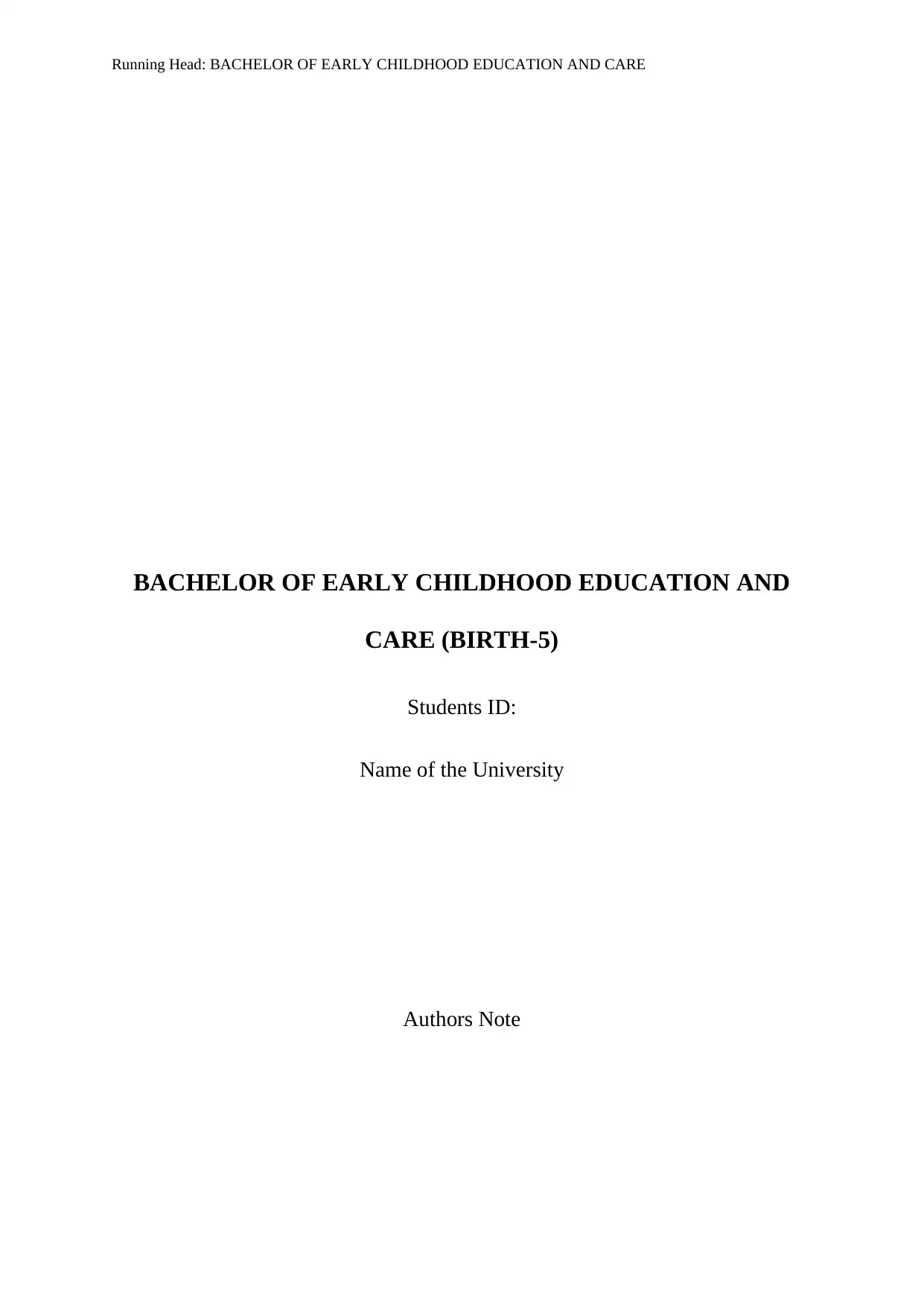
Running Head: BACHELOR OF EARLY CHILDHOOD EDUCATION AND CARE
BACHELOR OF EARLY CHILDHOOD EDUCATION AND
CARE (BIRTH-5)
Students ID:
Name of the University
Authors Note
BACHELOR OF EARLY CHILDHOOD EDUCATION AND
CARE (BIRTH-5)
Students ID:
Name of the University
Authors Note
Paraphrase This Document
Need a fresh take? Get an instant paraphrase of this document with our AI Paraphraser
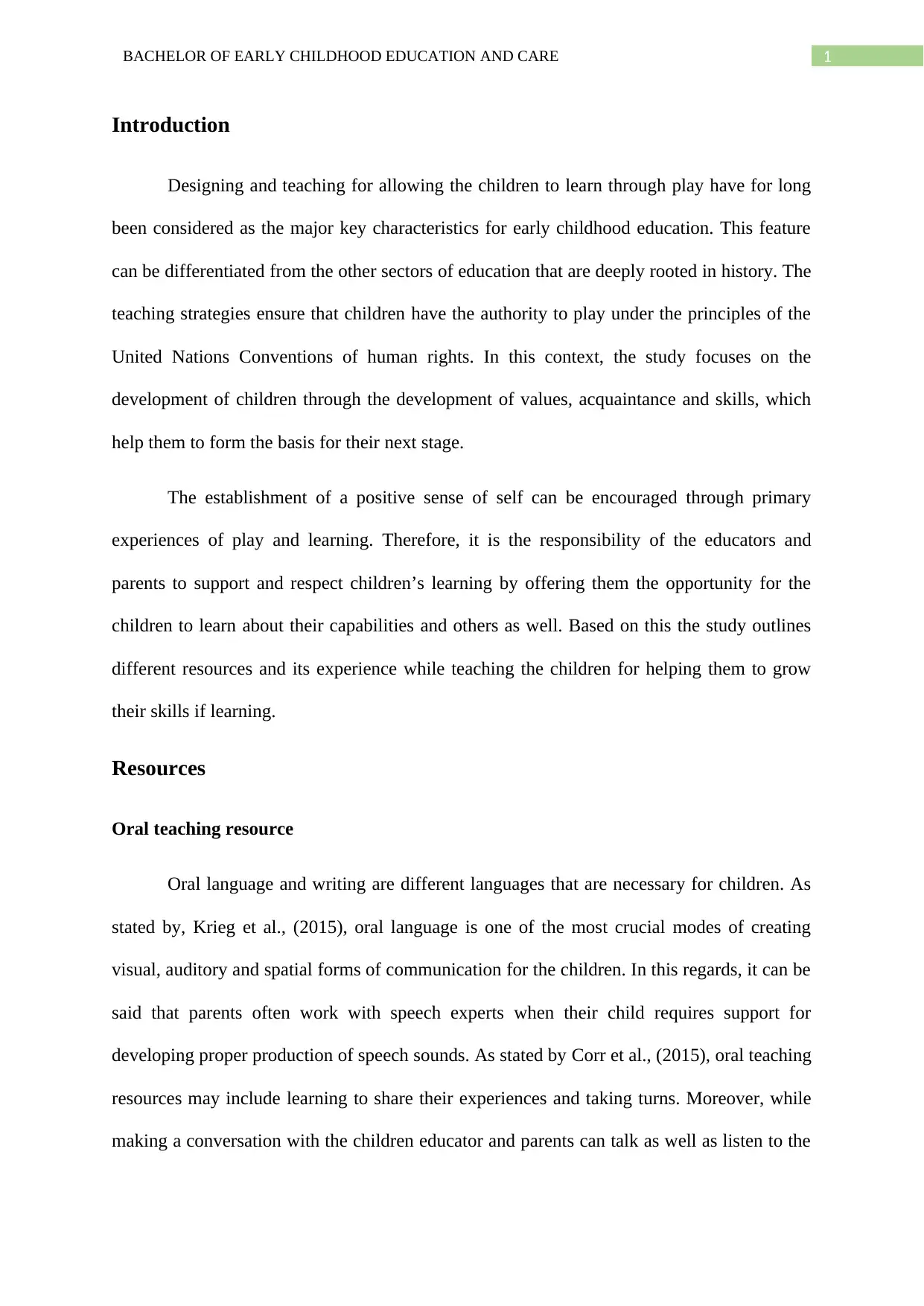
1BACHELOR OF EARLY CHILDHOOD EDUCATION AND CARE
Introduction
Designing and teaching for allowing the children to learn through play have for long
been considered as the major key characteristics for early childhood education. This feature
can be differentiated from the other sectors of education that are deeply rooted in history. The
teaching strategies ensure that children have the authority to play under the principles of the
United Nations Conventions of human rights. In this context, the study focuses on the
development of children through the development of values, acquaintance and skills, which
help them to form the basis for their next stage.
The establishment of a positive sense of self can be encouraged through primary
experiences of play and learning. Therefore, it is the responsibility of the educators and
parents to support and respect children’s learning by offering them the opportunity for the
children to learn about their capabilities and others as well. Based on this the study outlines
different resources and its experience while teaching the children for helping them to grow
their skills if learning.
Resources
Oral teaching resource
Oral language and writing are different languages that are necessary for children. As
stated by, Krieg et al., (2015), oral language is one of the most crucial modes of creating
visual, auditory and spatial forms of communication for the children. In this regards, it can be
said that parents often work with speech experts when their child requires support for
developing proper production of speech sounds. As stated by Corr et al., (2015), oral teaching
resources may include learning to share their experiences and taking turns. Moreover, while
making a conversation with the children educator and parents can talk as well as listen to the
Introduction
Designing and teaching for allowing the children to learn through play have for long
been considered as the major key characteristics for early childhood education. This feature
can be differentiated from the other sectors of education that are deeply rooted in history. The
teaching strategies ensure that children have the authority to play under the principles of the
United Nations Conventions of human rights. In this context, the study focuses on the
development of children through the development of values, acquaintance and skills, which
help them to form the basis for their next stage.
The establishment of a positive sense of self can be encouraged through primary
experiences of play and learning. Therefore, it is the responsibility of the educators and
parents to support and respect children’s learning by offering them the opportunity for the
children to learn about their capabilities and others as well. Based on this the study outlines
different resources and its experience while teaching the children for helping them to grow
their skills if learning.
Resources
Oral teaching resource
Oral language and writing are different languages that are necessary for children. As
stated by, Krieg et al., (2015), oral language is one of the most crucial modes of creating
visual, auditory and spatial forms of communication for the children. In this regards, it can be
said that parents often work with speech experts when their child requires support for
developing proper production of speech sounds. As stated by Corr et al., (2015), oral teaching
resources may include learning to share their experiences and taking turns. Moreover, while
making a conversation with the children educator and parents can talk as well as listen to the
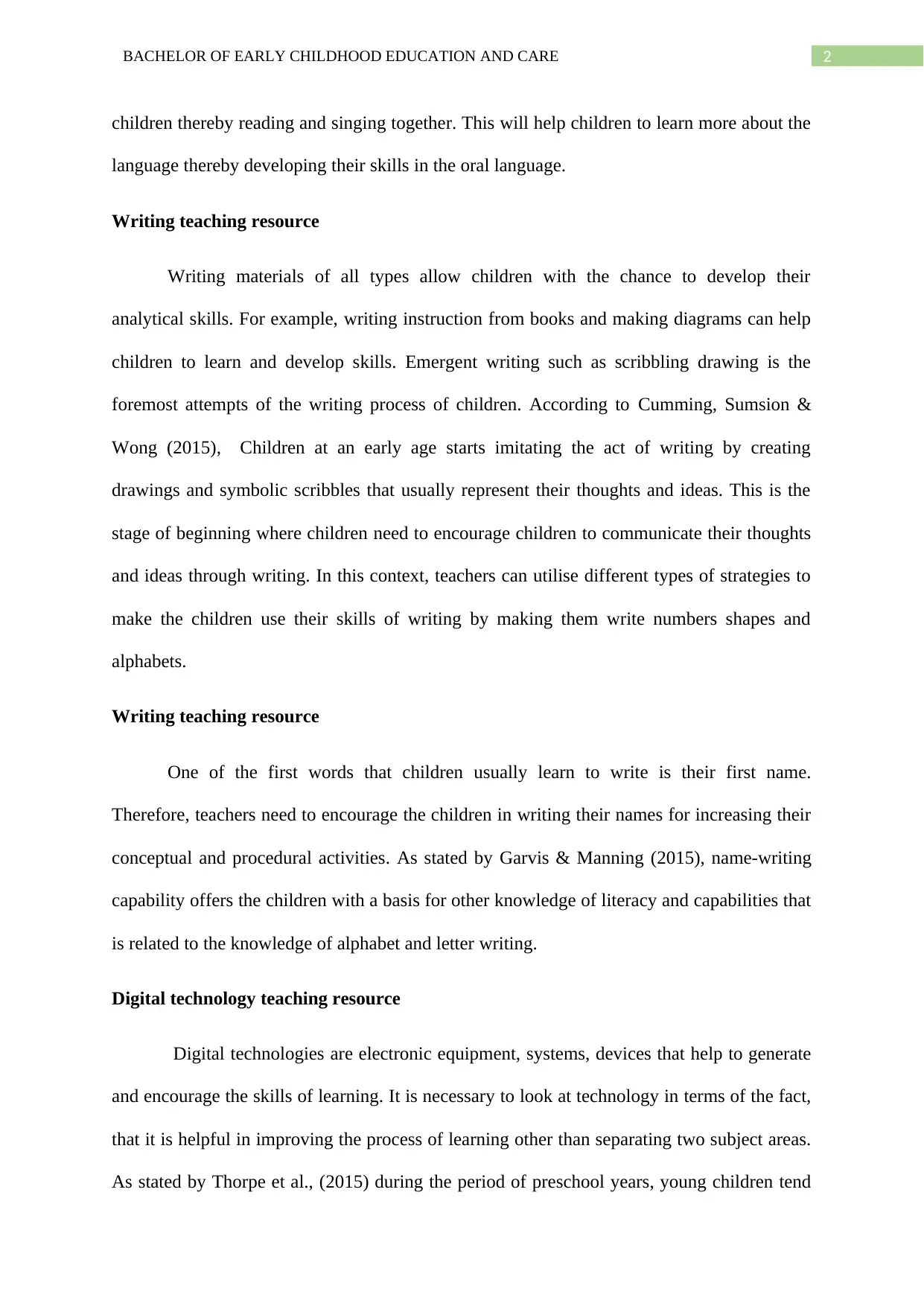
2BACHELOR OF EARLY CHILDHOOD EDUCATION AND CARE
children thereby reading and singing together. This will help children to learn more about the
language thereby developing their skills in the oral language.
Writing teaching resource
Writing materials of all types allow children with the chance to develop their
analytical skills. For example, writing instruction from books and making diagrams can help
children to learn and develop skills. Emergent writing such as scribbling drawing is the
foremost attempts of the writing process of children. According to Cumming, Sumsion &
Wong (2015), Children at an early age starts imitating the act of writing by creating
drawings and symbolic scribbles that usually represent their thoughts and ideas. This is the
stage of beginning where children need to encourage children to communicate their thoughts
and ideas through writing. In this context, teachers can utilise different types of strategies to
make the children use their skills of writing by making them write numbers shapes and
alphabets.
Writing teaching resource
One of the first words that children usually learn to write is their first name.
Therefore, teachers need to encourage the children in writing their names for increasing their
conceptual and procedural activities. As stated by Garvis & Manning (2015), name-writing
capability offers the children with a basis for other knowledge of literacy and capabilities that
is related to the knowledge of alphabet and letter writing.
Digital technology teaching resource
Digital technologies are electronic equipment, systems, devices that help to generate
and encourage the skills of learning. It is necessary to look at technology in terms of the fact,
that it is helpful in improving the process of learning other than separating two subject areas.
As stated by Thorpe et al., (2015) during the period of preschool years, young children tend
children thereby reading and singing together. This will help children to learn more about the
language thereby developing their skills in the oral language.
Writing teaching resource
Writing materials of all types allow children with the chance to develop their
analytical skills. For example, writing instruction from books and making diagrams can help
children to learn and develop skills. Emergent writing such as scribbling drawing is the
foremost attempts of the writing process of children. According to Cumming, Sumsion &
Wong (2015), Children at an early age starts imitating the act of writing by creating
drawings and symbolic scribbles that usually represent their thoughts and ideas. This is the
stage of beginning where children need to encourage children to communicate their thoughts
and ideas through writing. In this context, teachers can utilise different types of strategies to
make the children use their skills of writing by making them write numbers shapes and
alphabets.
Writing teaching resource
One of the first words that children usually learn to write is their first name.
Therefore, teachers need to encourage the children in writing their names for increasing their
conceptual and procedural activities. As stated by Garvis & Manning (2015), name-writing
capability offers the children with a basis for other knowledge of literacy and capabilities that
is related to the knowledge of alphabet and letter writing.
Digital technology teaching resource
Digital technologies are electronic equipment, systems, devices that help to generate
and encourage the skills of learning. It is necessary to look at technology in terms of the fact,
that it is helpful in improving the process of learning other than separating two subject areas.
As stated by Thorpe et al., (2015) during the period of preschool years, young children tend
⊘ This is a preview!⊘
Do you want full access?
Subscribe today to unlock all pages.

Trusted by 1+ million students worldwide
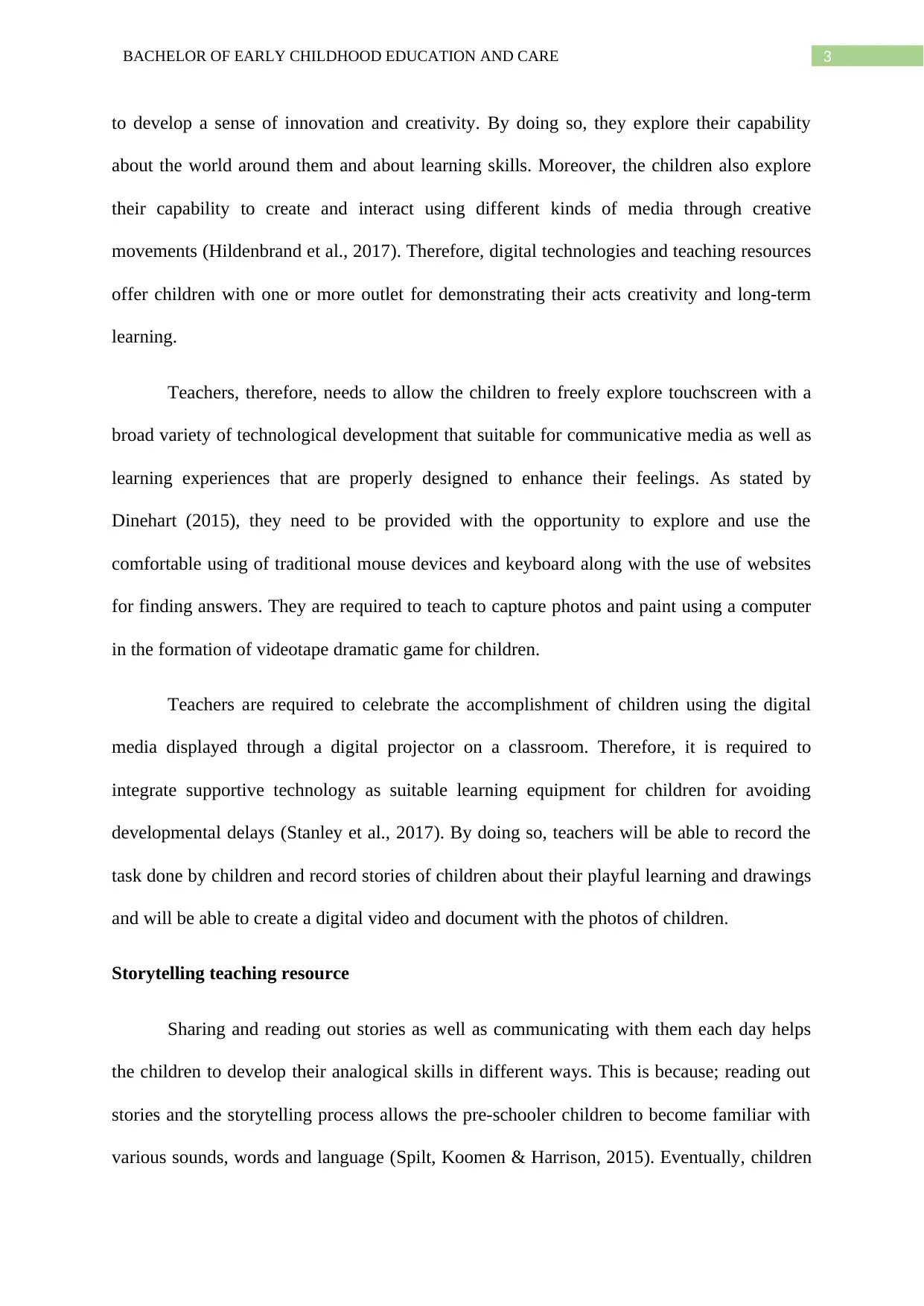
3BACHELOR OF EARLY CHILDHOOD EDUCATION AND CARE
to develop a sense of innovation and creativity. By doing so, they explore their capability
about the world around them and about learning skills. Moreover, the children also explore
their capability to create and interact using different kinds of media through creative
movements (Hildenbrand et al., 2017). Therefore, digital technologies and teaching resources
offer children with one or more outlet for demonstrating their acts creativity and long-term
learning.
Teachers, therefore, needs to allow the children to freely explore touchscreen with a
broad variety of technological development that suitable for communicative media as well as
learning experiences that are properly designed to enhance their feelings. As stated by
Dinehart (2015), they need to be provided with the opportunity to explore and use the
comfortable using of traditional mouse devices and keyboard along with the use of websites
for finding answers. They are required to teach to capture photos and paint using a computer
in the formation of videotape dramatic game for children.
Teachers are required to celebrate the accomplishment of children using the digital
media displayed through a digital projector on a classroom. Therefore, it is required to
integrate supportive technology as suitable learning equipment for children for avoiding
developmental delays (Stanley et al., 2017). By doing so, teachers will be able to record the
task done by children and record stories of children about their playful learning and drawings
and will be able to create a digital video and document with the photos of children.
Storytelling teaching resource
Sharing and reading out stories as well as communicating with them each day helps
the children to develop their analogical skills in different ways. This is because; reading out
stories and the storytelling process allows the pre-schooler children to become familiar with
various sounds, words and language (Spilt, Koomen & Harrison, 2015). Eventually, children
to develop a sense of innovation and creativity. By doing so, they explore their capability
about the world around them and about learning skills. Moreover, the children also explore
their capability to create and interact using different kinds of media through creative
movements (Hildenbrand et al., 2017). Therefore, digital technologies and teaching resources
offer children with one or more outlet for demonstrating their acts creativity and long-term
learning.
Teachers, therefore, needs to allow the children to freely explore touchscreen with a
broad variety of technological development that suitable for communicative media as well as
learning experiences that are properly designed to enhance their feelings. As stated by
Dinehart (2015), they need to be provided with the opportunity to explore and use the
comfortable using of traditional mouse devices and keyboard along with the use of websites
for finding answers. They are required to teach to capture photos and paint using a computer
in the formation of videotape dramatic game for children.
Teachers are required to celebrate the accomplishment of children using the digital
media displayed through a digital projector on a classroom. Therefore, it is required to
integrate supportive technology as suitable learning equipment for children for avoiding
developmental delays (Stanley et al., 2017). By doing so, teachers will be able to record the
task done by children and record stories of children about their playful learning and drawings
and will be able to create a digital video and document with the photos of children.
Storytelling teaching resource
Sharing and reading out stories as well as communicating with them each day helps
the children to develop their analogical skills in different ways. This is because; reading out
stories and the storytelling process allows the pre-schooler children to become familiar with
various sounds, words and language (Spilt, Koomen & Harrison, 2015). Eventually, children
Paraphrase This Document
Need a fresh take? Get an instant paraphrase of this document with our AI Paraphraser
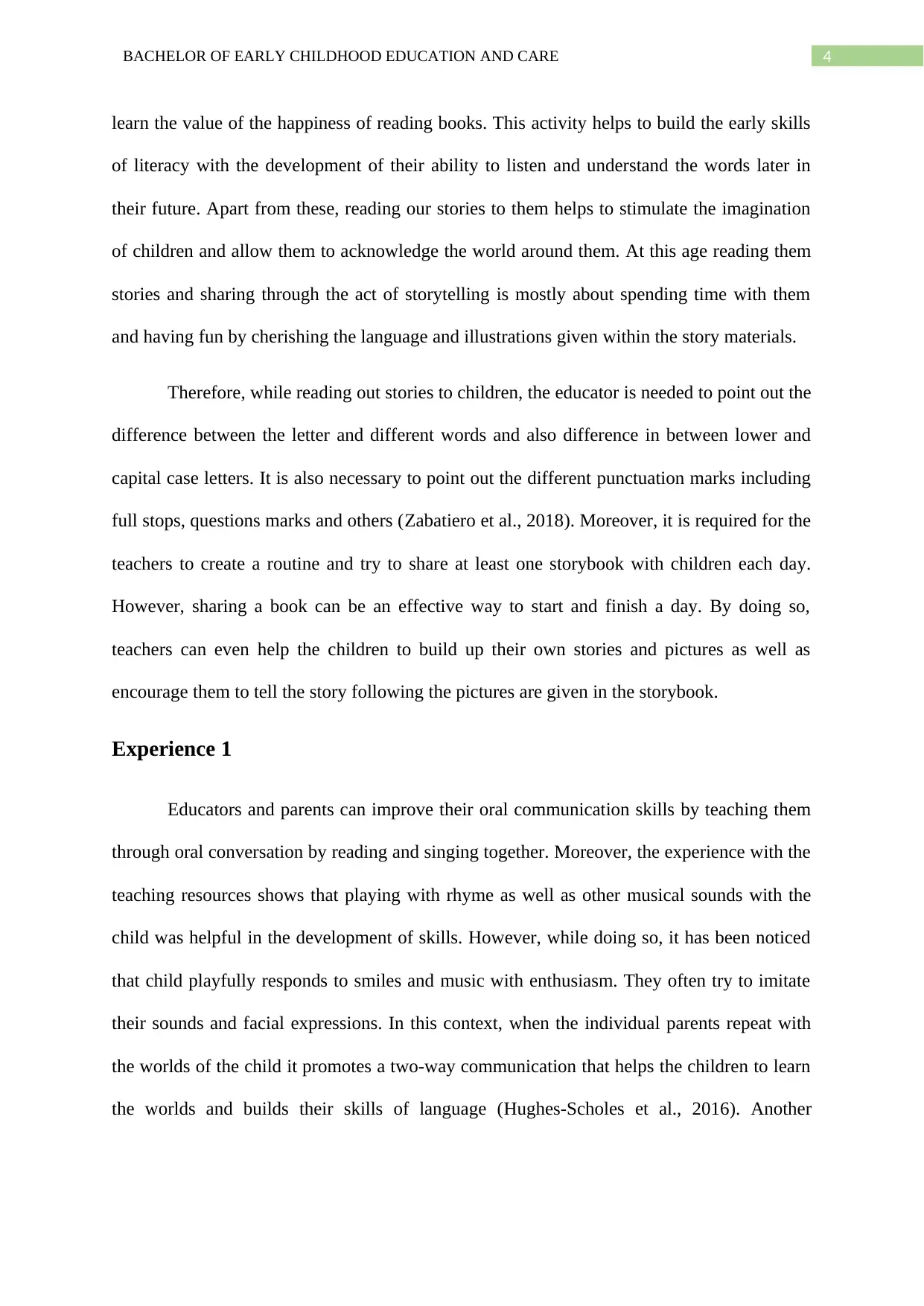
4BACHELOR OF EARLY CHILDHOOD EDUCATION AND CARE
learn the value of the happiness of reading books. This activity helps to build the early skills
of literacy with the development of their ability to listen and understand the words later in
their future. Apart from these, reading our stories to them helps to stimulate the imagination
of children and allow them to acknowledge the world around them. At this age reading them
stories and sharing through the act of storytelling is mostly about spending time with them
and having fun by cherishing the language and illustrations given within the story materials.
Therefore, while reading out stories to children, the educator is needed to point out the
difference between the letter and different words and also difference in between lower and
capital case letters. It is also necessary to point out the different punctuation marks including
full stops, questions marks and others (Zabatiero et al., 2018). Moreover, it is required for the
teachers to create a routine and try to share at least one storybook with children each day.
However, sharing a book can be an effective way to start and finish a day. By doing so,
teachers can even help the children to build up their own stories and pictures as well as
encourage them to tell the story following the pictures are given in the storybook.
Experience 1
Educators and parents can improve their oral communication skills by teaching them
through oral conversation by reading and singing together. Moreover, the experience with the
teaching resources shows that playing with rhyme as well as other musical sounds with the
child was helpful in the development of skills. However, while doing so, it has been noticed
that child playfully responds to smiles and music with enthusiasm. They often try to imitate
their sounds and facial expressions. In this context, when the individual parents repeat with
the worlds of the child it promotes a two-way communication that helps the children to learn
the worlds and builds their skills of language (Hughes-Scholes et al., 2016). Another
learn the value of the happiness of reading books. This activity helps to build the early skills
of literacy with the development of their ability to listen and understand the words later in
their future. Apart from these, reading our stories to them helps to stimulate the imagination
of children and allow them to acknowledge the world around them. At this age reading them
stories and sharing through the act of storytelling is mostly about spending time with them
and having fun by cherishing the language and illustrations given within the story materials.
Therefore, while reading out stories to children, the educator is needed to point out the
difference between the letter and different words and also difference in between lower and
capital case letters. It is also necessary to point out the different punctuation marks including
full stops, questions marks and others (Zabatiero et al., 2018). Moreover, it is required for the
teachers to create a routine and try to share at least one storybook with children each day.
However, sharing a book can be an effective way to start and finish a day. By doing so,
teachers can even help the children to build up their own stories and pictures as well as
encourage them to tell the story following the pictures are given in the storybook.
Experience 1
Educators and parents can improve their oral communication skills by teaching them
through oral conversation by reading and singing together. Moreover, the experience with the
teaching resources shows that playing with rhyme as well as other musical sounds with the
child was helpful in the development of skills. However, while doing so, it has been noticed
that child playfully responds to smiles and music with enthusiasm. They often try to imitate
their sounds and facial expressions. In this context, when the individual parents repeat with
the worlds of the child it promotes a two-way communication that helps the children to learn
the worlds and builds their skills of language (Hughes-Scholes et al., 2016). Another
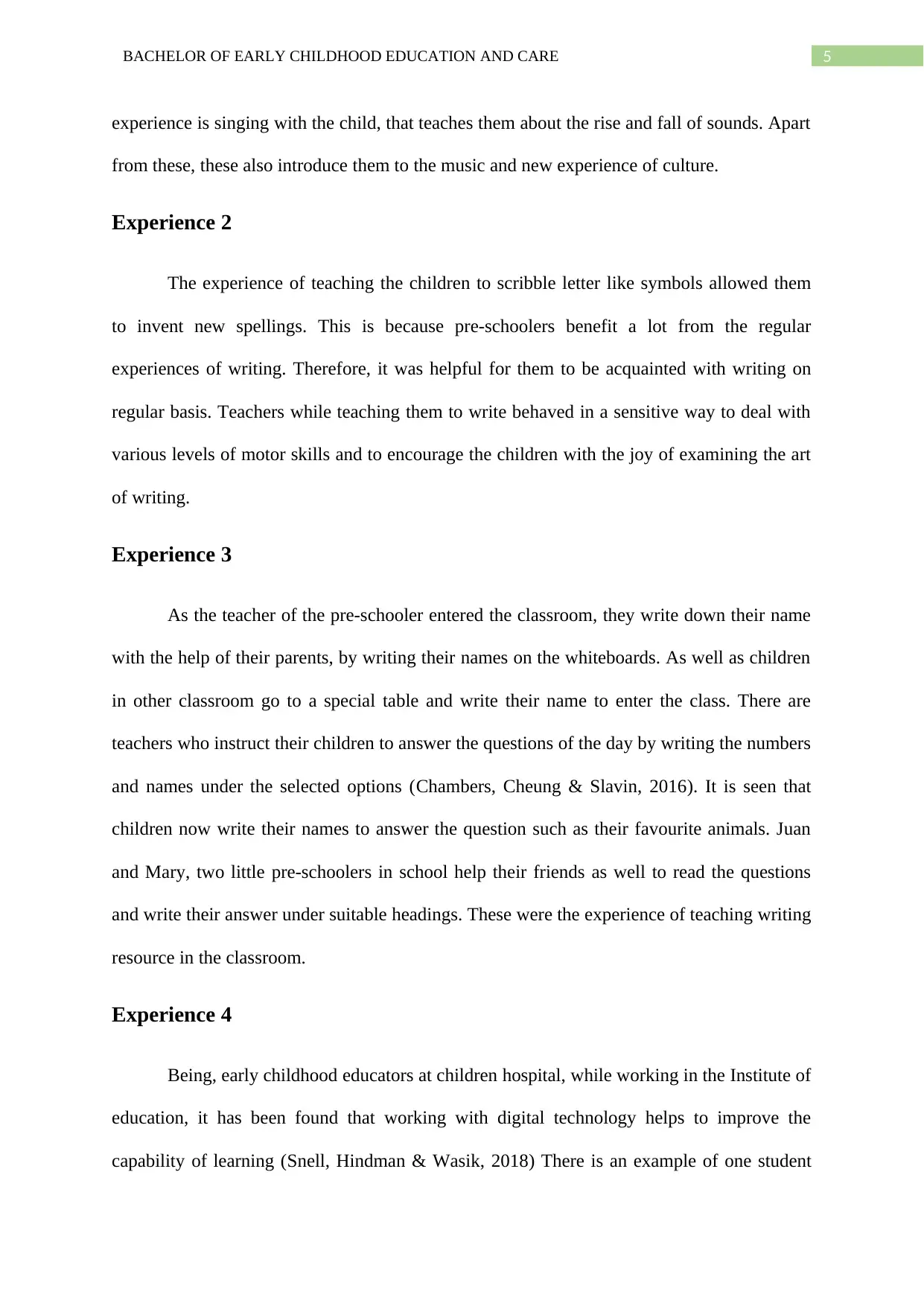
5BACHELOR OF EARLY CHILDHOOD EDUCATION AND CARE
experience is singing with the child, that teaches them about the rise and fall of sounds. Apart
from these, these also introduce them to the music and new experience of culture.
Experience 2
The experience of teaching the children to scribble letter like symbols allowed them
to invent new spellings. This is because pre-schoolers benefit a lot from the regular
experiences of writing. Therefore, it was helpful for them to be acquainted with writing on
regular basis. Teachers while teaching them to write behaved in a sensitive way to deal with
various levels of motor skills and to encourage the children with the joy of examining the art
of writing.
Experience 3
As the teacher of the pre-schooler entered the classroom, they write down their name
with the help of their parents, by writing their names on the whiteboards. As well as children
in other classroom go to a special table and write their name to enter the class. There are
teachers who instruct their children to answer the questions of the day by writing the numbers
and names under the selected options (Chambers, Cheung & Slavin, 2016). It is seen that
children now write their names to answer the question such as their favourite animals. Juan
and Mary, two little pre-schoolers in school help their friends as well to read the questions
and write their answer under suitable headings. These were the experience of teaching writing
resource in the classroom.
Experience 4
Being, early childhood educators at children hospital, while working in the Institute of
education, it has been found that working with digital technology helps to improve the
capability of learning (Snell, Hindman & Wasik, 2018) There is an example of one student
experience is singing with the child, that teaches them about the rise and fall of sounds. Apart
from these, these also introduce them to the music and new experience of culture.
Experience 2
The experience of teaching the children to scribble letter like symbols allowed them
to invent new spellings. This is because pre-schoolers benefit a lot from the regular
experiences of writing. Therefore, it was helpful for them to be acquainted with writing on
regular basis. Teachers while teaching them to write behaved in a sensitive way to deal with
various levels of motor skills and to encourage the children with the joy of examining the art
of writing.
Experience 3
As the teacher of the pre-schooler entered the classroom, they write down their name
with the help of their parents, by writing their names on the whiteboards. As well as children
in other classroom go to a special table and write their name to enter the class. There are
teachers who instruct their children to answer the questions of the day by writing the numbers
and names under the selected options (Chambers, Cheung & Slavin, 2016). It is seen that
children now write their names to answer the question such as their favourite animals. Juan
and Mary, two little pre-schoolers in school help their friends as well to read the questions
and write their answer under suitable headings. These were the experience of teaching writing
resource in the classroom.
Experience 4
Being, early childhood educators at children hospital, while working in the Institute of
education, it has been found that working with digital technology helps to improve the
capability of learning (Snell, Hindman & Wasik, 2018) There is an example of one student
⊘ This is a preview!⊘
Do you want full access?
Subscribe today to unlock all pages.

Trusted by 1+ million students worldwide
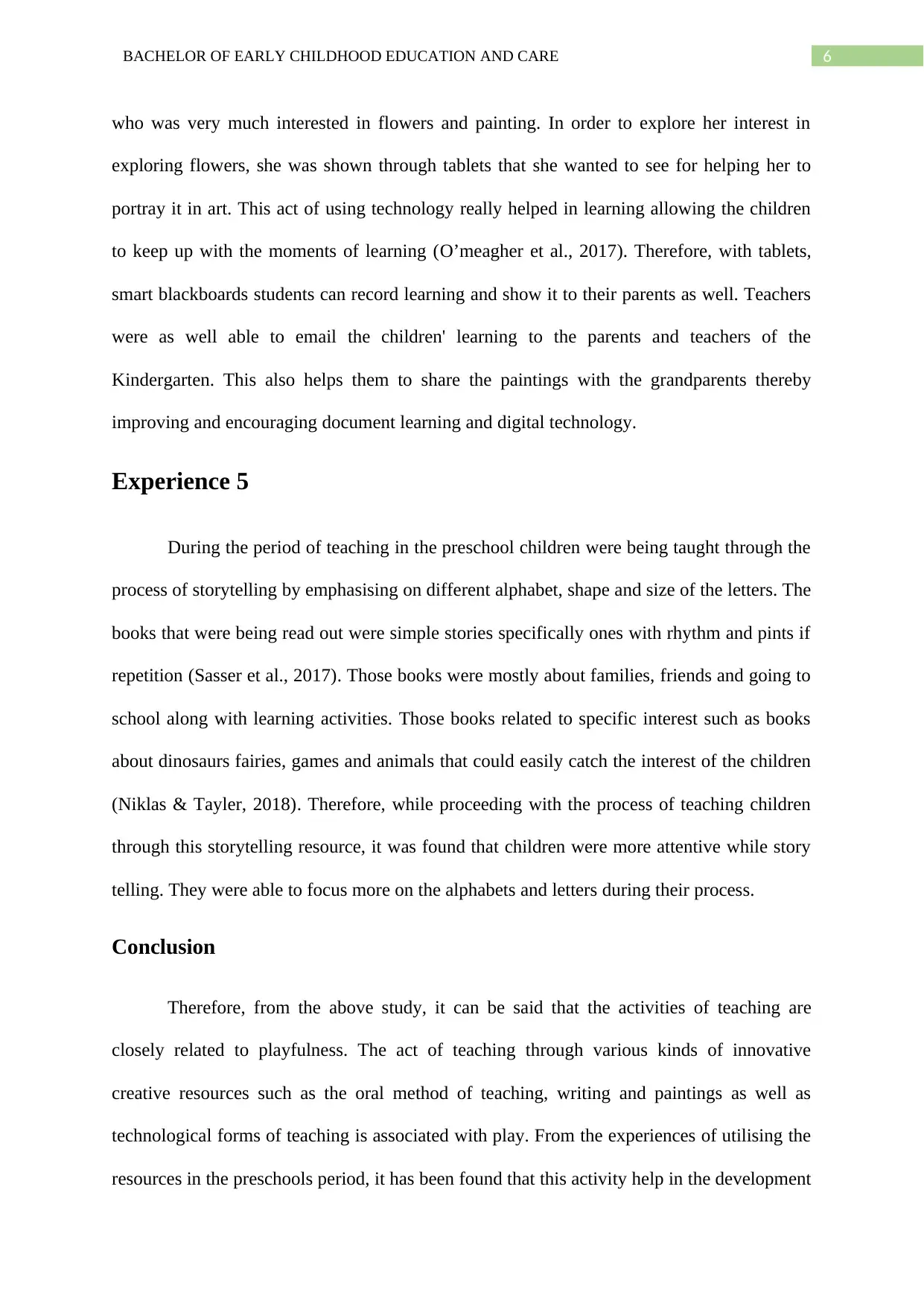
6BACHELOR OF EARLY CHILDHOOD EDUCATION AND CARE
who was very much interested in flowers and painting. In order to explore her interest in
exploring flowers, she was shown through tablets that she wanted to see for helping her to
portray it in art. This act of using technology really helped in learning allowing the children
to keep up with the moments of learning (O’meagher et al., 2017). Therefore, with tablets,
smart blackboards students can record learning and show it to their parents as well. Teachers
were as well able to email the children' learning to the parents and teachers of the
Kindergarten. This also helps them to share the paintings with the grandparents thereby
improving and encouraging document learning and digital technology.
Experience 5
During the period of teaching in the preschool children were being taught through the
process of storytelling by emphasising on different alphabet, shape and size of the letters. The
books that were being read out were simple stories specifically ones with rhythm and pints if
repetition (Sasser et al., 2017). Those books were mostly about families, friends and going to
school along with learning activities. Those books related to specific interest such as books
about dinosaurs fairies, games and animals that could easily catch the interest of the children
(Niklas & Tayler, 2018). Therefore, while proceeding with the process of teaching children
through this storytelling resource, it was found that children were more attentive while story
telling. They were able to focus more on the alphabets and letters during their process.
Conclusion
Therefore, from the above study, it can be said that the activities of teaching are
closely related to playfulness. The act of teaching through various kinds of innovative
creative resources such as the oral method of teaching, writing and paintings as well as
technological forms of teaching is associated with play. From the experiences of utilising the
resources in the preschools period, it has been found that this activity help in the development
who was very much interested in flowers and painting. In order to explore her interest in
exploring flowers, she was shown through tablets that she wanted to see for helping her to
portray it in art. This act of using technology really helped in learning allowing the children
to keep up with the moments of learning (O’meagher et al., 2017). Therefore, with tablets,
smart blackboards students can record learning and show it to their parents as well. Teachers
were as well able to email the children' learning to the parents and teachers of the
Kindergarten. This also helps them to share the paintings with the grandparents thereby
improving and encouraging document learning and digital technology.
Experience 5
During the period of teaching in the preschool children were being taught through the
process of storytelling by emphasising on different alphabet, shape and size of the letters. The
books that were being read out were simple stories specifically ones with rhythm and pints if
repetition (Sasser et al., 2017). Those books were mostly about families, friends and going to
school along with learning activities. Those books related to specific interest such as books
about dinosaurs fairies, games and animals that could easily catch the interest of the children
(Niklas & Tayler, 2018). Therefore, while proceeding with the process of teaching children
through this storytelling resource, it was found that children were more attentive while story
telling. They were able to focus more on the alphabets and letters during their process.
Conclusion
Therefore, from the above study, it can be said that the activities of teaching are
closely related to playfulness. The act of teaching through various kinds of innovative
creative resources such as the oral method of teaching, writing and paintings as well as
technological forms of teaching is associated with play. From the experiences of utilising the
resources in the preschools period, it has been found that this activity help in the development
Paraphrase This Document
Need a fresh take? Get an instant paraphrase of this document with our AI Paraphraser
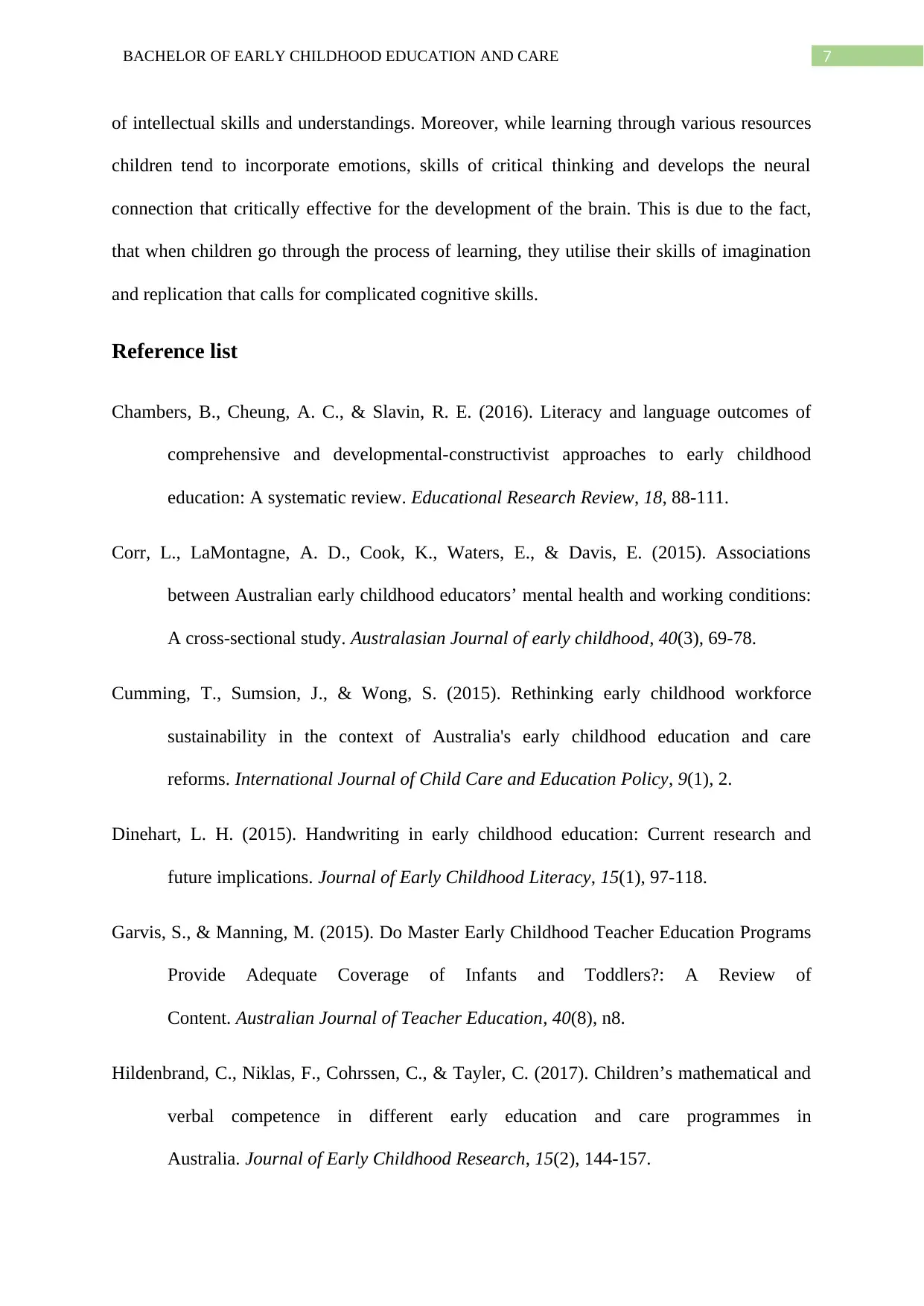
7BACHELOR OF EARLY CHILDHOOD EDUCATION AND CARE
of intellectual skills and understandings. Moreover, while learning through various resources
children tend to incorporate emotions, skills of critical thinking and develops the neural
connection that critically effective for the development of the brain. This is due to the fact,
that when children go through the process of learning, they utilise their skills of imagination
and replication that calls for complicated cognitive skills.
Reference list
Chambers, B., Cheung, A. C., & Slavin, R. E. (2016). Literacy and language outcomes of
comprehensive and developmental-constructivist approaches to early childhood
education: A systematic review. Educational Research Review, 18, 88-111.
Corr, L., LaMontagne, A. D., Cook, K., Waters, E., & Davis, E. (2015). Associations
between Australian early childhood educators’ mental health and working conditions:
A cross-sectional study. Australasian Journal of early childhood, 40(3), 69-78.
Cumming, T., Sumsion, J., & Wong, S. (2015). Rethinking early childhood workforce
sustainability in the context of Australia's early childhood education and care
reforms. International Journal of Child Care and Education Policy, 9(1), 2.
Dinehart, L. H. (2015). Handwriting in early childhood education: Current research and
future implications. Journal of Early Childhood Literacy, 15(1), 97-118.
Garvis, S., & Manning, M. (2015). Do Master Early Childhood Teacher Education Programs
Provide Adequate Coverage of Infants and Toddlers?: A Review of
Content. Australian Journal of Teacher Education, 40(8), n8.
Hildenbrand, C., Niklas, F., Cohrssen, C., & Tayler, C. (2017). Children’s mathematical and
verbal competence in different early education and care programmes in
Australia. Journal of Early Childhood Research, 15(2), 144-157.
of intellectual skills and understandings. Moreover, while learning through various resources
children tend to incorporate emotions, skills of critical thinking and develops the neural
connection that critically effective for the development of the brain. This is due to the fact,
that when children go through the process of learning, they utilise their skills of imagination
and replication that calls for complicated cognitive skills.
Reference list
Chambers, B., Cheung, A. C., & Slavin, R. E. (2016). Literacy and language outcomes of
comprehensive and developmental-constructivist approaches to early childhood
education: A systematic review. Educational Research Review, 18, 88-111.
Corr, L., LaMontagne, A. D., Cook, K., Waters, E., & Davis, E. (2015). Associations
between Australian early childhood educators’ mental health and working conditions:
A cross-sectional study. Australasian Journal of early childhood, 40(3), 69-78.
Cumming, T., Sumsion, J., & Wong, S. (2015). Rethinking early childhood workforce
sustainability in the context of Australia's early childhood education and care
reforms. International Journal of Child Care and Education Policy, 9(1), 2.
Dinehart, L. H. (2015). Handwriting in early childhood education: Current research and
future implications. Journal of Early Childhood Literacy, 15(1), 97-118.
Garvis, S., & Manning, M. (2015). Do Master Early Childhood Teacher Education Programs
Provide Adequate Coverage of Infants and Toddlers?: A Review of
Content. Australian Journal of Teacher Education, 40(8), n8.
Hildenbrand, C., Niklas, F., Cohrssen, C., & Tayler, C. (2017). Children’s mathematical and
verbal competence in different early education and care programmes in
Australia. Journal of Early Childhood Research, 15(2), 144-157.
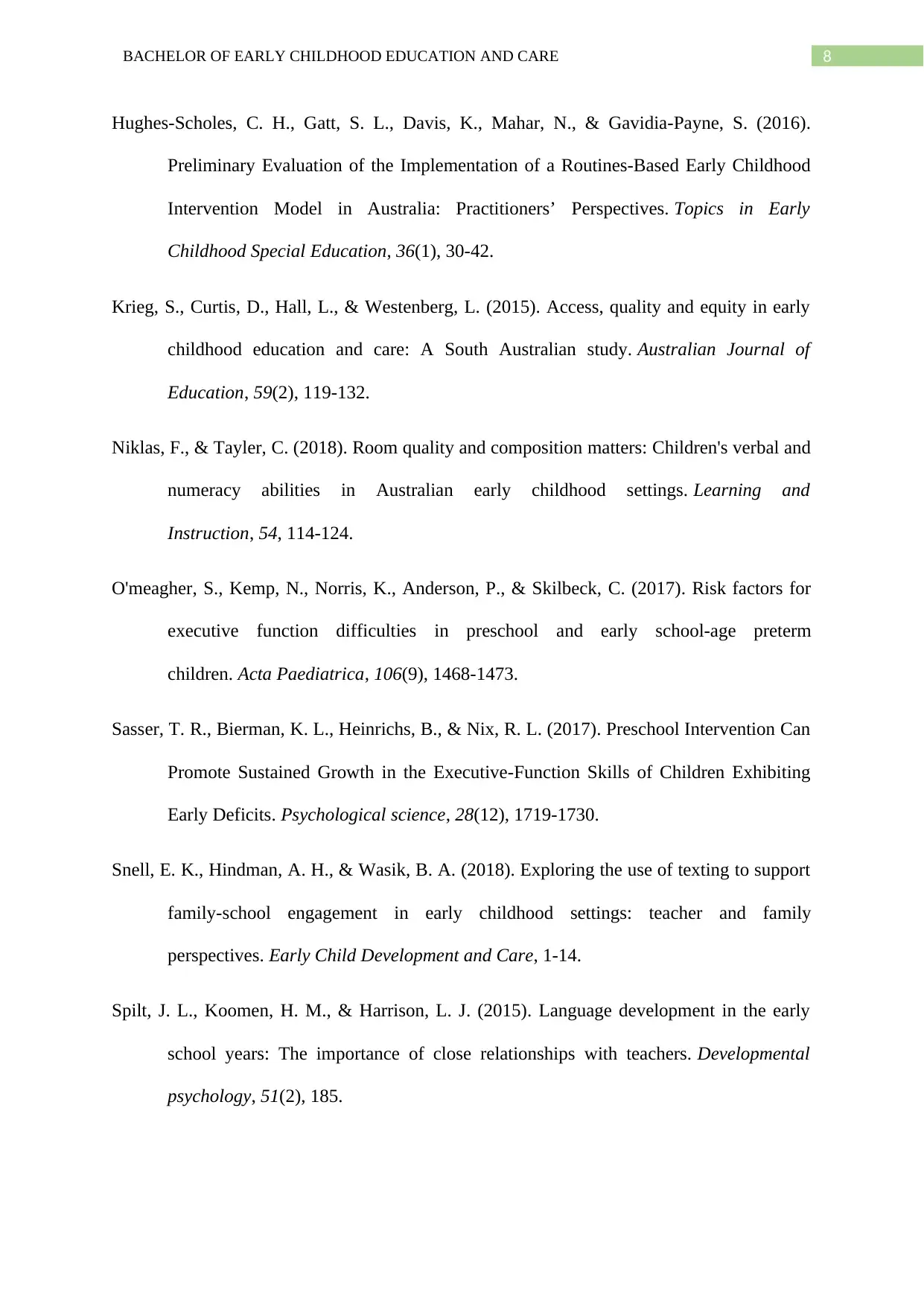
8BACHELOR OF EARLY CHILDHOOD EDUCATION AND CARE
Hughes-Scholes, C. H., Gatt, S. L., Davis, K., Mahar, N., & Gavidia-Payne, S. (2016).
Preliminary Evaluation of the Implementation of a Routines-Based Early Childhood
Intervention Model in Australia: Practitioners’ Perspectives. Topics in Early
Childhood Special Education, 36(1), 30-42.
Krieg, S., Curtis, D., Hall, L., & Westenberg, L. (2015). Access, quality and equity in early
childhood education and care: A South Australian study. Australian Journal of
Education, 59(2), 119-132.
Niklas, F., & Tayler, C. (2018). Room quality and composition matters: Children's verbal and
numeracy abilities in Australian early childhood settings. Learning and
Instruction, 54, 114-124.
O'meagher, S., Kemp, N., Norris, K., Anderson, P., & Skilbeck, C. (2017). Risk factors for
executive function difficulties in preschool and early school‐age preterm
children. Acta Paediatrica, 106(9), 1468-1473.
Sasser, T. R., Bierman, K. L., Heinrichs, B., & Nix, R. L. (2017). Preschool Intervention Can
Promote Sustained Growth in the Executive-Function Skills of Children Exhibiting
Early Deficits. Psychological science, 28(12), 1719-1730.
Snell, E. K., Hindman, A. H., & Wasik, B. A. (2018). Exploring the use of texting to support
family-school engagement in early childhood settings: teacher and family
perspectives. Early Child Development and Care, 1-14.
Spilt, J. L., Koomen, H. M., & Harrison, L. J. (2015). Language development in the early
school years: The importance of close relationships with teachers. Developmental
psychology, 51(2), 185.
Hughes-Scholes, C. H., Gatt, S. L., Davis, K., Mahar, N., & Gavidia-Payne, S. (2016).
Preliminary Evaluation of the Implementation of a Routines-Based Early Childhood
Intervention Model in Australia: Practitioners’ Perspectives. Topics in Early
Childhood Special Education, 36(1), 30-42.
Krieg, S., Curtis, D., Hall, L., & Westenberg, L. (2015). Access, quality and equity in early
childhood education and care: A South Australian study. Australian Journal of
Education, 59(2), 119-132.
Niklas, F., & Tayler, C. (2018). Room quality and composition matters: Children's verbal and
numeracy abilities in Australian early childhood settings. Learning and
Instruction, 54, 114-124.
O'meagher, S., Kemp, N., Norris, K., Anderson, P., & Skilbeck, C. (2017). Risk factors for
executive function difficulties in preschool and early school‐age preterm
children. Acta Paediatrica, 106(9), 1468-1473.
Sasser, T. R., Bierman, K. L., Heinrichs, B., & Nix, R. L. (2017). Preschool Intervention Can
Promote Sustained Growth in the Executive-Function Skills of Children Exhibiting
Early Deficits. Psychological science, 28(12), 1719-1730.
Snell, E. K., Hindman, A. H., & Wasik, B. A. (2018). Exploring the use of texting to support
family-school engagement in early childhood settings: teacher and family
perspectives. Early Child Development and Care, 1-14.
Spilt, J. L., Koomen, H. M., & Harrison, L. J. (2015). Language development in the early
school years: The importance of close relationships with teachers. Developmental
psychology, 51(2), 185.
⊘ This is a preview!⊘
Do you want full access?
Subscribe today to unlock all pages.

Trusted by 1+ million students worldwide
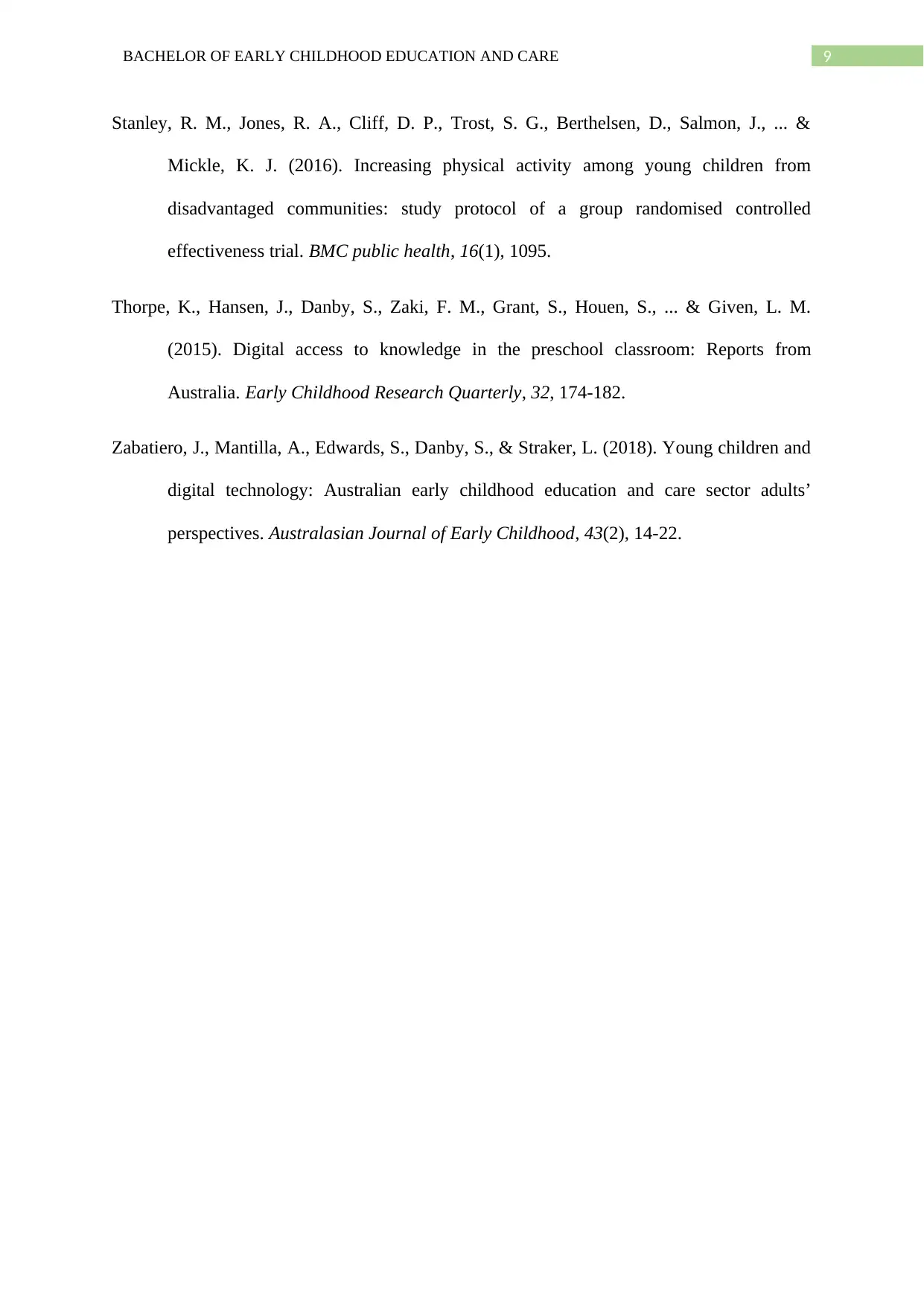
9BACHELOR OF EARLY CHILDHOOD EDUCATION AND CARE
Stanley, R. M., Jones, R. A., Cliff, D. P., Trost, S. G., Berthelsen, D., Salmon, J., ... &
Mickle, K. J. (2016). Increasing physical activity among young children from
disadvantaged communities: study protocol of a group randomised controlled
effectiveness trial. BMC public health, 16(1), 1095.
Thorpe, K., Hansen, J., Danby, S., Zaki, F. M., Grant, S., Houen, S., ... & Given, L. M.
(2015). Digital access to knowledge in the preschool classroom: Reports from
Australia. Early Childhood Research Quarterly, 32, 174-182.
Zabatiero, J., Mantilla, A., Edwards, S., Danby, S., & Straker, L. (2018). Young children and
digital technology: Australian early childhood education and care sector adults’
perspectives. Australasian Journal of Early Childhood, 43(2), 14-22.
Stanley, R. M., Jones, R. A., Cliff, D. P., Trost, S. G., Berthelsen, D., Salmon, J., ... &
Mickle, K. J. (2016). Increasing physical activity among young children from
disadvantaged communities: study protocol of a group randomised controlled
effectiveness trial. BMC public health, 16(1), 1095.
Thorpe, K., Hansen, J., Danby, S., Zaki, F. M., Grant, S., Houen, S., ... & Given, L. M.
(2015). Digital access to knowledge in the preschool classroom: Reports from
Australia. Early Childhood Research Quarterly, 32, 174-182.
Zabatiero, J., Mantilla, A., Edwards, S., Danby, S., & Straker, L. (2018). Young children and
digital technology: Australian early childhood education and care sector adults’
perspectives. Australasian Journal of Early Childhood, 43(2), 14-22.
1 out of 10
Related Documents
Your All-in-One AI-Powered Toolkit for Academic Success.
+13062052269
info@desklib.com
Available 24*7 on WhatsApp / Email
![[object Object]](/_next/static/media/star-bottom.7253800d.svg)
Unlock your academic potential
Copyright © 2020–2025 A2Z Services. All Rights Reserved. Developed and managed by ZUCOL.





